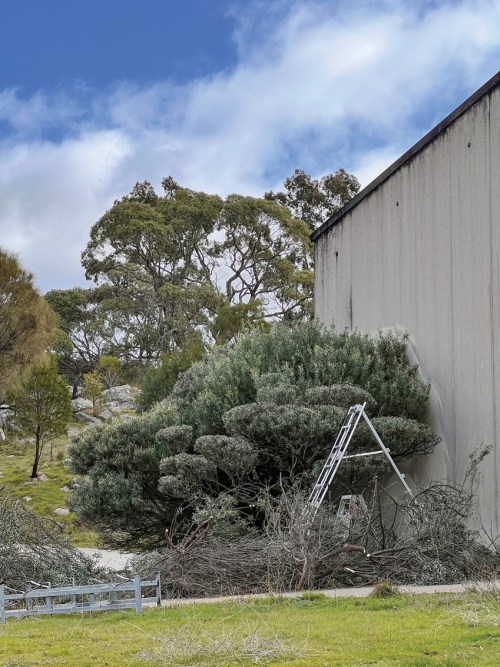Looking at your garden and deciding it needs a complete overhaul? Maybe, it’s simpler to look at the established plants and trees and give them a new life and purpose through creative pruning.
Head in the clouds
When designing a new garden or re-working an existing garden, I often look to create accents or features using plants in conjunction with landscape or architectural features. In new gardens, it’s easy to plan a space for a feature or architectural plant against a newly built backdrop and I often use plants that I’ve grown and shaped previously in similar situations.
But what about a garden that is due for renovation because it is overgrown or maybe lacks structure? Perhaps this garden is already home to mature trees or shrubs that have stood the test of time and developed to advanced status. If so, it would be a shame to knock them over only to replace them with new plants or trees, which need to be nurtured and trained for years before looking the part.

The first thing to do in this instance is to look at the existing trees and shrubs in the garden and consider whether or not they can be given a makeover and, therefore, a chance to become a feature plant or, in some cases, the star of the new landscape design.
For example, I was consulted by a Barossa winery about an established grevillea that was set to be removed during renovations to prepare for a wedding. I was asked about the options and whether the grevillea could be saved or did it need to be removed? Seeing the potential in this old grevillea, I was able to shape it to become a great feature tree, and it is now a talking point for visitors to the winery (plus, being an established tree, it requires very little maintenance).

Saving trees is great for many reasons. Firstly, for the environment, because keeping that carbon in the tree is essential. Secondly, for wildlife, because birds rely on established trees to have a safe space to perch. And finally, trees give us enjoyment through the shade they provide, while the established root system means less watering and fertilising.
Creative pruning looks at the internal structure of a plant, and gradually reveals its inner beauty by removing dead debris, internal clutter and pruning it away from other plants and structures, before deciding on its new look.

Cloud pruning is about exposing the branch structure of the tree, by stripping back the foliage along the branches, and clipping the foliage towards the ends of the branches, encouraging it to thicken up and form “pads” at the tips. Removing inwards-facing, dead and crowded branches allow light and air to move through the plant. When doing this you will notice natural twists and turns of the branches and get a feel for which branches will create beneficial or interesting features. Starting at the bottom, remove branches as you spiral upwards, spacing the branches evenly around the trunk of the plant, so each branch fills its own space, aiming to avoid branches that are touching or on top of one another.

At the top of the plant, decide where to prune the leading branches and begin to form the “head” of the plant. At this stage you are also deciding the height and overall proportion of the plant. Shapes of the pads and head can vary depending on the type of plant you use, or the style you are aiming to achieve. A more formal look is achieved by trimming into balls, or you may decide to trim into elongated pads, removing foliage from the underside of the branch and encouraging a longer, thinner effect. With this style, you can also bend and manipulate branches to a more horizontal position, creating the more windswept niwaki (Japanese) feel. Manipulating branches, using wires, pulleys, canes/sticks or splints can also be used to move branches into place where they are not conflicting or spaced more evenly for a more pleasing aesthetic.

Maintaining the cloud tree, after forming the initial structure, can be as simple as regular pruning to shape, encouraging the pads to thicken up, fill in holes and grow to desired length and shape. Cloud pruning trees, such as maples, can be less formal, but concentrating on the overall appearance of the tree by thinning out branches, exaggerating twists and turns, loosely forming pads and exposing their natural form, even when the branches are bare in winter, can create interest for deciduous trees.

When choosing shrubs or trees for cloud pruning, you are looking for plants which respond to pruning by putting out new shoots thus thickening up and forming denser foliage where you want it. Examples are hedging plants such as buxus japonica, conifers such as Leighton Green, and even natives such as melaleuca, callistemon and grevillea. You may find woody weeds such as self-seeded olives also lend themselves to cloud pruning. The beauty of cloud pruning is the tree decides the outcome and therefore each one is unique.

The result is guided by the plant’s individual character and your creativity. Pruning like this allows light and airflow into the garden, better line of sight and a feeling of space and structure.
Cloud pruning is a certain crowd pleaser, but for some plants a simple crown lift (removing lower branches) exposing its legs (or trunk) and shaping the canopy to a mushroom shape is enough.



